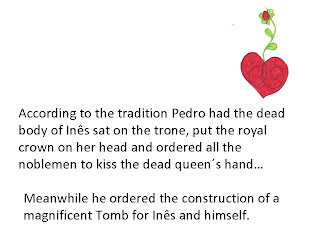This Legend was rewritten and ilustrated by our Comenius group.
4 Aug 2009
These are Pedro and Inês as we see them.
We have a video about the story of Pedro and Inês.
On the following website you can download the video:
http://www.malhatlantica.pt/netlink/important.html
16 May 2009
24 Mar 2009
Today starts the schoolweek exhibition!!
This will be our last year in this project.
Please leave a comment in our blog.
We thank you for all the support and your kindness through all these three years of activities!!!
The Portuguese Comenius Group.
Posted by Castles and Palaces, History and Legends at 14:48 36 coments
22 Mar 2009
Regulamento do concurso
A Lenda dos Amores de D. Pedro e D. Inês de Castro
Trabalhos dos alunos do grupo em diferentes modalidades:
Versão Texto da Dramatização
Versão Sonora/MP3
Versão Vídeo
Versão Desenho/Pintura
Quem são os elementos do grupo?
Como foi abordado o projecto?
Como foram desenvolvidas as actividades?
21 Mar 2009

The Legend of the Enchanted Cave
Near the hills of Sintra there is a rock with a special shape, which is said to mark the entrance of a way into the castle of Sintra. It is called the Moors Cave or the Enchanted Cave and it is related to a legend from the times when the Moors inhabited Sintra and fought with the Christians in their frequent incursions.
In one of their many combats a Christian noble man was made captive and Zaida, the Alcayde’s daughter fell in love with him. Day after day she visited the noble Christian, until he was to be released by the payment of a ransom. He also fell in love with her and he asked her to run away with him but she refused, asking him never to forget her.
The noble knight went back to his family but a great sadness shadowed his days. He tried to forget Zaida in the battlefields but after many sleepless nights he decided to attack Sintra castle again.
During that battle the two lovers hugged and the unfortunate knight fell hurt. Zaida took him through a secret passage, into a room hidden in the caves. While Zaida filled a vase with water in a spring nearby, her was also hit by a spear and she fell down too.
The brave knight, missing his beloved Zaida, went for her and found her near the spring. He fell beside her and both bloods mixed together. Later they were found dead side by side.
Since then, it is said that, in certain full moon nights, near the cave, a beautiful young lady in white comes to fill a vase with water and disappears in the night with a long and painful moan.

The Legend of Martim Moniz
The name Martim Moniz is linked to the conquest of Lisbon to the Moors and in his memory there is a square in the city with his name.
The legend tells us that D. Afonso Henriques had surrounded the walls of the city, he was helped by the Crusades who passed through there on their way to the Holy Land.
In an attempt to break one of the doors of the city, Martim Moniz faced the moors head on, so that the Christians could get into the city.
This cost him severe injuries. His body was crossed between the two jambs and allowed the Christians to enter the city. Seriously wounded, Martim Moniz, entered the castle with his friends and managed to kill some of his enemies before he himself fell to the ground and died.
D. Afonso Henriques wanted to honour his braveness and the sacrifice of his life, so he declared that the entrance would have the name of Martim Moniz. The people say that D. Afonso Henriques ordered the hero's bust to be placed on a rock next to where he fell. It remains there still today in Martim Moniz's Square.

The legend of St. George and the Dragon
The cult of this saint seems to have been introduced in Portugal by the English Crusaders that helped D. Afonso Henriques in the conquest of Lisbon, in 1147.
Nuno Álvares Perreira was devoted to this martyr and ordered the saint’s image to be painted on his flag. It was D. João I who chose St. George as the name of the castle.
This saint was born in Capadocia, he was known for his braveness and conviction for the Christian religion.
When emperor Diocletian decreed the persecution to the Christians, George opposed him, for this the emperor ordered him to be tortured. Miraculously, the wheel of acute tips that should have cut him into pieces, left him intact. Only after many vicissitudes and persecutions, George finaly was decapitated on 23 of April of 290.
According to the legend, in Silene, city of Libya, there was a dragon to which the people made daily offerings, normally two sheep. One certain day, however, it was necessary to offer a human sacrifice to calm the dragon. The king's only daughter was the chosen one. George appeared in the city at that precise moment when they where sacrificing the child, and immediately freed her and fought the monster. He mounted his horse and attacked the dragon, killing it.













